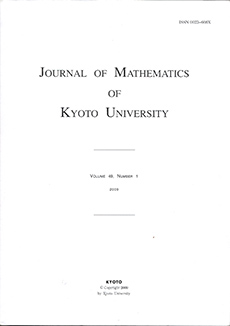Abstract
In this paper we consider the quadratic form $\phi [x] = \sum _{i=1}^{n} x_{i}^{2}$ over the vector space $\mathbb{Q}_{n}^{1}$. We take a $\mathbb{Z}$-maximal lattice $L$ in $\mathbb{Q}_{n}^{1}$ with respect to $\phi$. Let $\{L^{(i)}\}_{i=1}^{k(n)}$ be a complete set of representatives for the classes belonging to the genus of $L$. Applying Shimura's mass formula, we determine these representatives $L^{(i)}$ explicitly for $n = 11, 13$, and $14$. Consequently we obtain class numbers $k(11) = 3$, $k(13) = 4$, and $k(14) = 4$.
Citation
Takahiro Hiraoka. "On the class number of the genus of $\mathbb{Z}$-maximal lattices with respect to quadratic form of the sum of squares." J. Math. Kyoto Univ. 46 (2) 291 - 302, 2006. https://doi.org/10.1215/kjm/1250281778
Information





